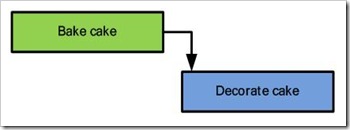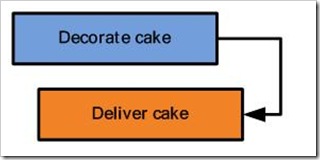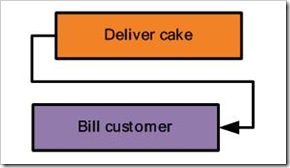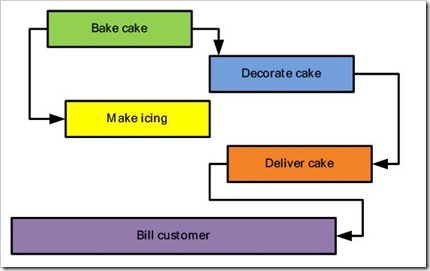Back to Basics: Understanding task dependencies
In most cases, the tasks in a project are related to each other, and the relationships between them drive the schedule for the project. The relationships between the tasks are called "dependencies." In Microsoft Office Project, you can create dependencies between tasks in the same project, and between tasks in different projects.
What kinds of task dependencies are available?
Project offers four kinds of task dependencies: finish-to-start, start-to-start, finish-to-finish, and start-to-finish.
First, let's talk about finish-to-start (FS) dependencies. This is the most common type of dependency and is the default type of dependency that Project uses. In a finish-to-start dependency, the second task in the relationship can't begin until the first task finishes. So, for example, if you were planning a project to make a wedding cake, you might use a finish-to-start dependency between the "Bake cake" and "Decorate cake" tasks. When the "Bake cake" task is finished, the "Decorate cake" task begins.

Start-to-start (SS) dependencies are used when the second task in the relationship can't begin until after the first task in the relationship begins. Start-to-start dependencies don't require that both tasks start at the same time. They simply require that the first task has begun, in order for the second task to begin. Going back to the wedding cake example, let's say you had planned to make the icing for the cake while the cake is baking in the oven. You can't start making the icing until the cake has started baking, so you might use a start-to-start dependency between the "Bake cake" and "Make icing" tasks.

If one of your tasks can't finish until another one finishes, you can use a finish-to-finish (FF) dependency between them. Finish-to-finish dependencies don't require that both tasks be completed simultaneously. They simply require that the first task be finished, in order for the second task to finish. The second task can finish any time after the first task finishes. In our wedding cake example, let's say there are some finishing touches to the decorations that you can't finish until the cake is delivered. You can use a finish-to-finish dependency between the "Decorate cake" and "Deliver cake" tasks. When the "Decorate cake" task is finished, then the "Deliver cake" task can be completed.

Finally, the start-to-finish (SF) dependency is a little tricky. When you use this type of dependency, you are saying that the second task in the relationship can't finish until the first task starts. However, the second task can finish any time after the first task starts. Going back to our wedding cake example, let's say you have a task for billing the customer. It begins when the customer requests the cake, but it can't be completed until after the cake delivery has begun. You can use a start-to-finish dependency between the "Deliver cake" and "Bill customer" tasks, so that when the "Deliver cake" task has begun, it is okay for the "Bill customer" task to finish.

So when you put the entire plan together, with these dependencies intact, the plan might look something like this:

How do I create dependencies?
First, you need to determine whether you want to create a dependency between two tasks in the same project, or between a task in one project and a task in another project.
If you want to create a dependency between two tasks in the same project, review Create task dependencies (links) within your project.
If you want to create a dependency between a task in one project and a task in another project, review Create task dependencies (links) across projects.
Where can I learn more?
Learn more about task dependencies in the following articles:
· View and update task dependencies (links) across projects
· Create and link tasks with Project 2007
· Watch this: Create a cross-project link
· Watch this: Link tasks in your project
· Change or remove task dependencies (links)
Comments
Anonymous
July 28, 2008
PingBack from http://todaysbargainelectronics.com/back-to-basics-understanding-task-dependencies/Anonymous
February 03, 2010
Outstanding, thank you for this. Helped me really well.Anonymous
July 15, 2010
How about if you want one task to Start AND Finish at the same time as another task. How can you do this?Anonymous
July 20, 2010
You can't directly set a task to start and finish at the same times as another task with dependencies. You can do this indirectly through paste links, this article has more information on this - support.microsoft.com/.../141733Anonymous
March 04, 2011
This is definitely more helpful to me than the construction examples one usually finds. However, I'm still confused about your example for FF. In the verbeage, you say "decorations -- can't finish until the cake is delivered" which sounds like Decorate Cake is FF dependent on Delivery to me, not Delivery dependent of Decorating...Anonymous
April 15, 2011
Oh lord thank you. this REALLY helps me to get the Start to Finish dependencyAnonymous
April 20, 2011
How to start a task when any of 3 predessors finishes? ThanksAnonymous
April 26, 2011
Mike - For the FF example assume that you have some decorating you need to do on site and then once that is finished the customer would sign the final delivery confirmation which would end the delivery task. The customer wouldn't want to sign until everything was finished since they'd want to make sure the cake was what they ordered. Ahamd - I don't believe there is a way to model this in Project.Anonymous
September 23, 2011
How do you link tasks so that both start at the same time?Anonymous
September 23, 2011
How do you link tasks so that both start at the same time?Anonymous
January 26, 2012
Question for an MS Project expert - is there a way to link multiple 'finish' tasks to a finish-to-start dependency. In the house building analogy, I don't want to start the drywall task until both the plumbing and electrical inspection tasks have been completedAnonymous
February 05, 2012
Do you recommend linking phases?